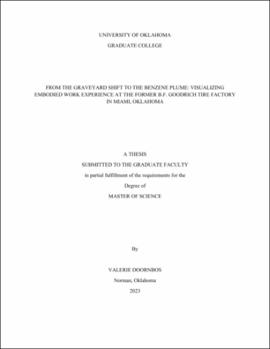| dc.description.abstract | From the time of its construction in 1944, to its eventual closure on February 28, 1986, the B.F. Goodrich Tire Factory in Miami, Oklahoma has played an important role in the community. During its 40-year lifetime, it was one of the largest employers in the Ottawa County and Tri-State region (Oklahoma, Kansas, and Missouri), employing over 2,000 workers at its peak. As one community member has noted, “when people got a job at B.F. Goodrich, they thought they had a job for life.” However, this was not to be. On August 23, 1985, a company executive announced that the plant would close in six months, citing increasing competition from foreign producers. In the years following the closure, the site switched owners numerous times while becoming dilapidated. There are also concerns surrounding the use of various chemicals in the production process and an unclear situation regarding who is responsible for cleanup. As a result, the residents of Miami continue to face the consequences of lasting environmental degradation and health concerns.
As part of my MS thesis project, I am undertaking multi-faceted mixed-method analysis that seeks to answer the question: how can a Miami community-based organization’s archival materials be incorporated into a StoryMap to engage a community, illustrate the embodied work experience, and introduce the environmental impacts of the five key areas of concern stemming from the plant closure?
Through the use of a variety of quantitative and qualitative data and methods, this research showcases the stories of those who lived, worked, and interacted with the B.F. Goodrich Tire Factory (in the following referred to as “the plant"), where five key items contribute to environmental contamination concerns: Benzene, Asbestos, Carbon Black, Underground Storage Tanks (USTs), and a Solid Waste Disposal Site. To examine these materials and their impacts, I (and others) have conducted a series of interviews with community members about their experiences with environmental contamination and the slow violence resulting from lengthy clean-up endeavors, as well as important areas within the factory site. Additionally, I have organized and analyzed a series of related documents (primarily court proceedings, images, and corporate correspondence) and interviews. I used this qualitative data combined with point locations derived from on-site photographs, to create a community-based B.F. Goodrich ArcGIS Story Map that visualizes work experience at the plant and highlights the environmental and societal impacts stemming from the closure.
After conducting this analysis, I found that: 1. Contamination is a very slow process and slow remediation and observation efforts are needed to address this. 2. Deindustrialization in the United States creates lingering negative societal and environmental impacts. 3. Participatory research (including archival and interviews) that centers the voices of residents via the creation of a StoryMap is a promising strategy for visualizing the events of the Miami plant.
By highlighting community stories, we gain a better understanding of deindustrialization and its connections to places such as Miami across the United States. | en_US |

